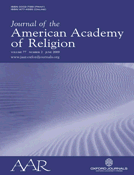-
Views
-
Cite
Cite
Kim Knott, Spatial Theory and Spatial Methodology, Their Relationship and Application: A Transatlantic Engagement, Journal of the American Academy of Religion, Volume 77, Issue 2, June 2009, Pages 413–424, https://doi.org/10.1093/jaarel/lfp031
Close - Share Icon Share
Extract
THE AIM OF THIS PAPER is to consider further the relationship between theory and methodology in the study of religion by engaging Thomas Tweed's theory of “crossing and dwelling” with my own spatial methodology.1 Both of these were constructed with issues of space, location, position, and movement in mind. In Crossing and Dwelling: A Theory of Religion, Tweed writes, “I was looking for a theory that made sense of the religious life of transnational migrants and addressed three themes—movement, relation and position” (5). His theory was developed inductively from in-depth field study of a particular case, that of the diasporic religion of Cuban Catholics in Miami. As he demonstrates, however, his theory reaches beyond this case, inviting application to other transnational religious examples and, potentially, to those not informed directly by the history, narratives, or practices associated with diaspora or migration.
Knott's methodology—in The Location of Religion: A Spatial Analysis—arose from the intention
Her work grew out of earlier interests, of studying religion “in locality” (Knott 2009), and, indeed, Tweed also noted its significance for understanding identity and religion. In addition to their initial spatial interests—Tweed particularly in movement and flow, Knott in location and space—both scholars extend their use of spatial terminology to their own position or standpoint (Tweed: 20–27; Knott 2005a: 2–3, 89–93), taking a locative approach to the development of theory and method.to look closely at contemporary everyday spaces in order to discern the location of religion within them, by considering its dynamic relations with the other features of those spaces (social, cultural, political, physical, economic), the place of religion in their structure, its active and passive modes, and its possibilities for dominance, resistance and liberation. (5)





